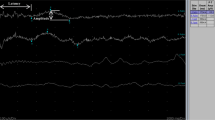Abstract
Purpose
Cutaneous sympathetic pathophysiology in complex regional pain syndrome type 1 (CRPS-1) is not yet completely understood. To evaluate cutaneous sympathetic dysfunction in CRPS-1, we evaluated sympathetic sweat response (SSwR) and skin vasomotor reflex (SkVR) in CRPS-1 patients.
Methods
We studied 10 CRPS-1 patients (age 41 ± 13 years; 5 females and 5 males; disease duration 20 ± 22 months) and 10 healthy subjects (age 44 ± 13 years; 3 females and 7 males). SkVRs and SSwRs to several sympathetic activating procedures were recorded on the palms of the CRPS-1 patients (affected side) and controls (right side).
Results
There were no significant differences in the baselines of sweat output and skin blood flow between the CRPS-1 and control groups. SSwR and SkVR amplitudes were significantly lower in the CRPS-1 group than in the control group. There was no significant correlation between disease duration and SSwR or SkVR amplitudes among the patients.
Conclusions
The reduced SSwRs and SkVRs in the affected limb of our CRPS-1 patients may reflect underlying damage to the sympathetic postganglionic fibres.




Similar content being viewed by others
References
Oklander AL, Fields HL (2009) Is reflex sympathetic dystrophy/complex regional pain syndrome type I a small-fiber neuropathy? Ann Neurol 65:629–638. doi:10.1002/ana.21692
Van der Laan L, Ter Laak HJ, Gabreels-Festen A, Gabreels F, Goris RJ (1998) Complex regional pain syndrome type I (RSD): pathology of skeletal muscle and peripheral nerve. Neurology 51:20–25
Albrecht PJ, Hines S, Eisenberg E, Pud D, Finlay DR, Connolly MK, Pare M, Davar G, Rice FL (2006) Pathologic alterations of cutaneous innervation and vasculature in affected limbs from patients with complex regional pain syndrome. Pain 120:244–266
Asahina M, Kikkawa Y, Suzuki A, Hattori T (2003) Cutaneous sympathetic function in patients with multiple system atrophy. Clin Auton Res 13:91–95
Akaogi Y, Asahina M, Yamanaka Y, Koyama Y, Hattori T (2009) Sudomotor, skin vasomotor, and cardiovascular reflexes in 3 clinical forms of Lewy body disease. Neurology 73:59–65. doi:10.1212/WNL.0b013e3181aae83c
Bruehl S, Harden RN, Galer BS, Saltz S, Bertram M, Backonia M, Gayles R, Rudin N, Bhugra MK, Stanton-Hicks M (1999) External validation of IASP diagnostic criteria for complex regional pain syndrome and proposed research diagnostic criteria. International Association for the Study of Pain. Pain 81:147–154
Birklein F, Sittl R, Spitzer A, Claus D, Neundorfer B, Handwerker HO (1997) Sudomotor function in sympathetic reflex dystrophy. Pain 69:49–54
Wasner G, Heckmann K, Maier C, Baron R (1999) Vascular abnormalities in acute reflex sympathetic dystrophy (CRPS-1): complete inhibition of sympathetic nerve activity with recovery. Arch Neurol 56:613–620
Harden RN, Duc TA, Williams TR, Coley D, Cate JC, Gracely RH (1994) Norepinephrine and epinephrine levels in affected versus unaffected limbs in sympathetically maintained pain. Clin J Pain 10:324–330
Birklein F, Schmelz M (2008) Neuropeptides, neurogenic inflammation and complex regional pain syndrome (CRPS). Neurosci Lett 437:199–202. doi:10.1016/j.neulet.2008.03.08
Birklein F, Schmelz M, Schifter S, Weber M (2001) The important role of neuropeptides in complex regional pain syndrome. Neurology 57:2179–2184
Marinus J, Moseley GL, Birklein F, Baron R, Maihofner C, Kingery WS, Van Hilten JJ (2011) Clinical features and pathophysiology of complex regional pain syndrome. Lancet Neurol 10:637–648
Schinkel C, Gaerter A, Zaspel J, Zedler S, Faist E, Schuermann M (2006) Inflammatory mediators are altered in the acute phase of posttraumatic complex regional pain syndrome. Clin J Pain 22:235–239
Clinchot DM, Lorch F (1996) Sympathetic skin response in patients with reflex sympathetic dystrophy. Am J Phys Med Rehabil 75:252–256
Drory VE, Korczyn AD (1995) The sympathetic skin response in reflex sympathetic dystrophy. J Neurol Sci 128:92–95
Rommel O, Tegenthoff M, Pern U, Strumpf M, Zenz M, Malin JP (1995) Sympathetic skin response in patients with reflex sympathetic dystrophy. Clin Auton Res 5:205–210
Lindh B, Pelto-Huikko M, Schalling M, Lundberg JM, Hokfelt T (1989) Substance P mRNA is present in a population of CGRP-immunoreactive cholinergic postganglionic sympathetic neurons of the cat: evidence from combined in situ hybridization and immunohistochemistry. Neurosci Lett 107:1–5
Ishida-Yamamoto A, Tohyama M (1990) Calcitonin gene-related peptide-like immunoreactive cells in the secretory portions of rat sweat glands. Cell Tissue Res 260:621–623
Zancanaro C, Mucignat-Caretta C, Merigo F, Osculati F (1999) Neuropeptide expression in the mouse vomeronasal organ during postnatal development. NeuroReport 10:2023–2027
Schlereth T, Dittmar JO, Seewald B, Birklein F (2006) Peripheral amplification of sweating-a role for calcitonin gene-related peptide. J Physiol 576:823–832
Kumazawa K, Sobue G, Mitsuma T, Ogawa T (1994) Modulatory effects of calcitonin gene-related peptide and substance P on human cholinergic sweat secretion. Clin Autonomic Res 4:319–322
Berg TJ, Levy DM, Reid G, Abraham RR (1995) The effects of vasoactive intestinal polypeptide and substance P on methacholine-induced sweating and vascular flare in diabetic neuropathy. Clin Auton Res 5:159–164
Vetrugno R, Liguori R, Cortelli P, Montagna P (2003) Sympathetic skin response. Basic mechanism and clinical applications. Clin Auton Res 13:256–270
Acknowledgments
No funding was obtained from outside the University.
Author information
Authors and Affiliations
Corresponding author
Ethics declarations
Conflict of interest
The authors declare that they have no conflict of interest.
Ethical approval
The study design was approved by the ethics committee of Chiba University, Graduate School of Medicine.
Informed consent
Written informed consent was obtained from all participants.
Rights and permissions
About this article
Cite this article
Poudel, A., Asahina, M., Fujinuma, Y. et al. Skin sympathetic function in complex regional pain syndrome type 1. Clin Auton Res 25, 367–371 (2015). https://doi.org/10.1007/s10286-015-0314-x
Received:
Accepted:
Published:
Issue Date:
DOI: https://doi.org/10.1007/s10286-015-0314-x




